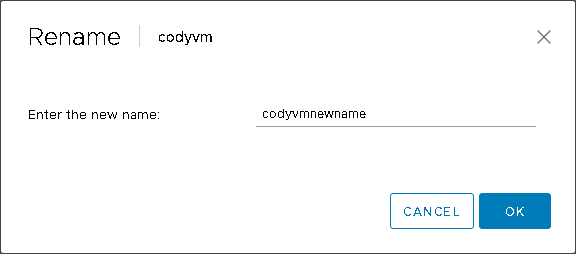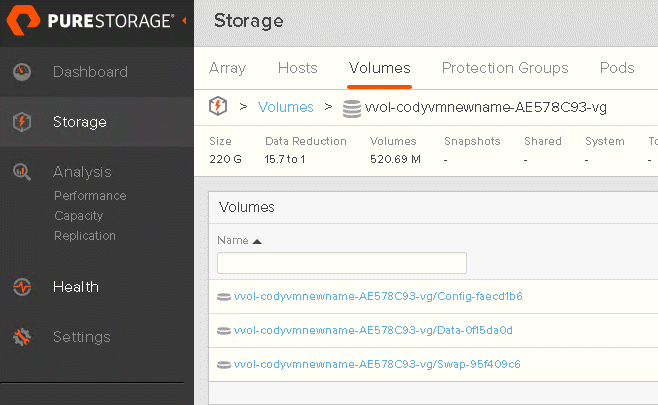The FlashArray implementation of Virtual Volumes surfaces VMs on the FlashArray as standard volume groups. The volume group being named by the virtual machine name. Each VVol is then added and removed to the volume group as they are provisioned or deleted. These objects though are fairly flexible–we do not use the volume group as a unique identifier of the virtual machine–internally we use key/value tags for that.
The benefit of that design is that you can delete the volume groups, rename them, or add and remove other volumes to it. Giving you some flexibility to group related VMs or whatever your use case might be to move things around, without breaking our VVol implementation.
So I if I deleted the volume group, or someone renamed it how can I easily fix it? Another use case is what if I rename the VM? How do I update volume group name?
Well you can certainly log into the GUI and fix it. Or use our CLI. But scripting this is the best way to go, to make sure things are correct. VVols are identified by VMware via UUIDs and we offer up VVol UUIDs in our REST, which can be retrieved in any number of ways. In this example PowerShell.
In my PowerShell module:
https://www.codyhosterman.com/scripts-and-tools/pure-storage-powershell-vmware-module/
One of the cmdlets that exists is called update-faVvolVmVolumeGroup. This takes in a few options, a VM object, a FlashArray IP/FQDN, and credentials to the FlashArray. It then goes and looks to see if a volume group exists for that VM, and if it does, if it has the right name. If it does not exist, or does not have the right name, it will create it/or rename it as needed.
Note you should be on at least the 1.2.0.2 version of the module to do everything listed in this post.
PS C:\Users\cody> get-help update-pfaVvolVmVolumeGroup
NAME
update-pfaVvolVmVolumeGroup
SYNOPSIS
Updates the volume group on a FlashArray for a VVol-based VM.
SYNTAX
update-pfaVvolVmVolumeGroup [[-vm] <VirtualMachine[]>] [[-purevip] <String>] [[-faCreds] <PSCredential>]
[[-datastore] <Datastore>] [[-flasharray] <PureArray>] [<CommonParameters>]
DESCRIPTION
Takes in a VM and a FlashArray connection. A volume group will be created if it does not exist, if it does, the
name will be updated if inaccurate. Any volumes for the given VM will be put into that group.
RELATED LINKS
REMARKS
To see the examples, type: "get-help update-pfaVvolVmVolumeGroup -examples".
For more information, type: "get-help update-pfaVvolVmVolumeGroup -detailed".
For technical information, type: "get-help update-pfaVvolVmVolumeGroup -full".
Let’s walk through some examples.
First I have a new VM called App08 and on my array the volume group has been deleted by some no-good scoundrel.

My VVols are not in a volume group (one data, one config and one swap).
The VM and everything works fine, just not ideal from a GUI management perspective–so I want to recreate the volume group.
So in PowerCLI, I first connect to vCenter:
connect-viserver -Server vcenter-pureThen store your VM in an object:
$vm = get-vm app08Now import the module if it isn’t (or install it if it isn’t–see instructions on how to in the link earlier in this post).
import-module PureStorage.FlashArray.VMwareNow create a connection to your FlashArray
new-pfaconnection -EndPoint <FlashArray IP/FQDN> -credentials -IgnoreCertificateError
Finally, pipe the VM into the cmdlet and also pass in the credentials and the FlashArray FQDN/IP.
$vm |update-faVvolVmVolumeGroup The cmdlet will create the volume group, add the volumes to it, and then return all of the new names of the volumes that have been put into the volume group.
On the FlashArray you can see the new volume group:

Another situation is if I rename the VM. I want to update the volume group.

So I change “codyvm” to “codyvmnewname”. If I rerun the same cmdlet as above it will update the volume group name.

The cmdlet also works at scale. The VM input can also be an array of VMs like below:
PS C:\Users\Administrator> $vm = get-vm -Name "vm-*"
PS C:\Users\Administrator> $vm
Name PowerState Num CPUs MemoryGB
---- ---------- -------- --------
vm-0016 PoweredOn 4 16.000
vm-0014 PoweredOn 4 16.000
vm-0017 PoweredOn 4 16.000
vm-0013 PoweredOn 4 16.000
vm-0019 PoweredOn 4 16.000
vm-0011 PoweredOn 4 16.000
vm-009 PoweredOn 4 16.000
vm-0018 PoweredOn 4 16.000
vm-000 PoweredOn 4 16.000
vm-006 PoweredOn 4 16.000
vm-0015 PoweredOn 4 16.000
vm-0012 PoweredOn 4 16.000
vm-002 PoweredOn 4 16.000
vm-004 PoweredOn 4 16.000
vm-007 PoweredOn 4 16.000
vm-003 PoweredOn 4 16.000
vm-005 PoweredOn 4 16.000
vm-001 PoweredOn 4 16.000
vm-0010 PoweredOn 4 16.000
vm-008 PoweredOn 4 16.000So I am storing all of those VMs in a variable and then I can pass it to the cmdlet either through pipline:
$vm | update-pfaVvolVmVolumeGroupOr through the parameter:
update-pfaVvolVmVolumeGroup -vm $vmAnother option is a whole datastore, if I want to update the volume groups for all of the VMs on a given VVol datastore, I can instead just pass in the datastore.
$datastore = get-datastore FlashArray-VVolDS-FA1 update-pfaVvolVmVolumeGroup -datastore $datastore
You have the option to pipeline it in as well:
$datastore | update-faVvolVmVolumeGroup
If you pass in a non-Pure, non-VVol datastore it will fail the process. Also if you pass in an array of VMs and one or more is either not a VVol VM, or not on that specified FlashArray, it will be skipped.
The last thing to note is that is returns the names of all of the volumes it affected, so store the response in a variable if you want to then do something to those volumes:
$volumes = $datastore | update-pfaVvolVmVolumeGroup $volumes vvol-vm-0012-FF6FFE58-vg/Config-0b28c59e vvol-vm-0012-FF6FFE58-vg/Data-592f7f3c vvol-vm-0012-FF6FFE58-vg/Swap-10cc12a0 vvol-vm-0014-C2EC5EE9-vg/Config-4b7e5f7d vvol-vm-0014-C2EC5EE9-vg/Data-93cd7b04 vvol-vm-0014-C2EC5EE9-vg/Swap-5b708bf7 vvol-vm-0016-21AC193D-vg/Config-fded266e vvol-vm-0016-21AC193D-vg/Data-ed504825 vvol-vm-0016-21AC193D-vg/Swap-bd37efb2
NOTE: This also comes in handy in vSphere 6.7 Update 1. There is a change in how VMware formulates the API calls to VASA for VM creation where we do not get the VM name where we expect, so the volume group does not get created. This is fixed in Purity 5.1.9. If you are running 6.7 U1 or later update to this release.

Thanks Cody for the detailed blog ! It’s very helpful to create a volume group for the vms deployed in vSphere 6.7 Update 1.
To help others , I would recommend to use the latest PowerCLI version to work with latest vSphere releases.
The update-faVvolVmVolumeGroup no longer works per examples above.
I get “WARNING: purevip will be deprecated in a future version. Please pass in only the flasharray parameter.
WARNING: faCreds will be deprecated in a future version. Please use new-pfaarray and pass in only the flasharray parameter.”
When I try using -flasharray $myArray, I get that I am mising faCreds
#region Working Code
#region Variables
$vcenter =”FQDN name of vCenter”
$cluster =”Datastore Cluster Name”
$PUREarray =”FQDN of Pure Storage VIP”
$PUREuser =”Array Admin on Pure”
$PUREpswd =”password (clear text) for testing”
$VVOLdatastore =”VMware VVol Datastore Name”
#endregion Variables
Connect-VIServer $vcenter
$SecurePassword = ConvertTo-SecureString -String $PUREpswd -AsPlaintext -Force
$myArray =New-PfaArray -username $PUREuser -Password $SecurePassword -EndPoint $PUREarray -IgnoreCertificateError
$PureHosts = Get-PfaHosts -Array $myArray
ForEach ($PureHost in $PureHosts) {
Get-PfaHostVolumeConnections -Array $myArray -Name $PureHost.Name
}
$PureHostGroups = Get-PfaHostGroups -Array $myArray
ForEach ($PureHostGroup in $PureHostGroups) {
Get-PfaHostGroupVolumeConnections -Array $myArray -HostGroupName $PureHostGroup.Name
}
#endregion Working Code
#region Code has errors
$vm = get-vm dc1-wsus03
$vm | update-faVvolVmVolumeGroup -flasharray $myArray
$datastore = get-datastore $VVOLdatastore
$volumes = $datastore | update-faVvolVmVolumeGroup -flasharray $myArray
#endregion Code has errors
Let me take a look. I added these deprecation warnings (working on updating that post) and might’ve screwed something up
Okay, I found a few issues, run update-module and use 1.2.0.2. That should fix the issue, let me know if it does not.
It worked! Thanks for the quick fix!
Great! Sure thing!
This is awesome! Came up when I googled trying to create something on my own. Saving time!